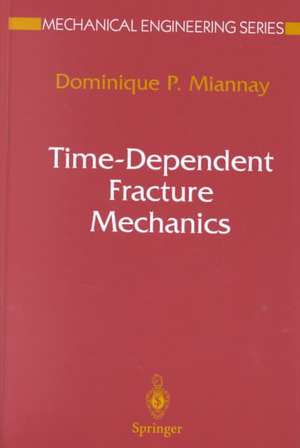Time-Dependent Fracture Mechanics: Mechanical Engineering (Springer-Verlag Telos Hardcover)
Autor Dominique P. Miannay, D. Miannayen Limba Engleză Hardback – 31 mai 2001
Preț: 594.21 lei
Preț vechi: 699.07 lei
-15% Nou
Puncte Express: 891
Preț estimativ în valută:
113.74€ • 123.59$ • 95.60£
113.74€ • 123.59$ • 95.60£
Carte tipărită la comandă
Livrare economică 21 aprilie-05 mai
Preluare comenzi: 021 569.72.76
Specificații
ISBN-13: 9780387952123
ISBN-10: 0387952128
Pagini: 458
Dimensiuni: 162 x 244 x 27 mm
Greutate: 0.86 kg
Ediția:and
Editura: Springer
Seria Mechanical Engineering (Springer-Verlag Telos Hardcover)
Locul publicării:New York, NY, United States
ISBN-10: 0387952128
Pagini: 458
Dimensiuni: 162 x 244 x 27 mm
Greutate: 0.86 kg
Ediția:and
Editura: Springer
Seria Mechanical Engineering (Springer-Verlag Telos Hardcover)
Locul publicării:New York, NY, United States
Public țintă
ResearchCuprins
Chapter 1--Structural Integrity Assessment: The Relevant Fracture Toughness Evaluation / Chapter 2--Structural Integrity Assessment / Chapter 3--Dynamic Fracture: Elementary Dynamics and Microscopic Fracture / Chapter 4--Dynamic Fracture Mechanics: The Stationary Crack / Chapter 5: Dynamic Fracture Mechanics: The Moving Crack / Chapter 6--Creep Fracture: Creep Laws, Elementary Microscopic Fracture Models, and Rupture of Smooth Bars / Chapter 7--Creep Fracture Mechanics / Chapter 8--Fatigue and Creep-Fatigue
Recenzii
From the reviews of the first edition:
"Intended for engineers, researchers, and graduate students dealing with materials science, structural design, and non-destructive testing and evaluation, 'Time-Dependent Fracture Mechanics' by D. Miannay represents a continuation of the author's book 'Fracture Mechanics' from 1997. The discussion of design codes and procedures will be of use to practicing engineers ... the extensive bibliography and discussion of recent results will make it a useful reference for academic researchers; and graduate students will find clear explanations and worked examples." (Materialprüfung, Vol. 44 (5), 2002)
"The book is devoted to the failure of cracked bodies, and its content is divided into three main logical parts. ... On the whole, the monograph could be recommended as reference book to postgraduate students, scientists and engineers working in the field of structural design, nondestructive evaluation and safety assessment." (Ján Sládek, Zentralblatt MATH, Vol. 977, 2002)
"Intended for engineers, researchers, and graduate students dealing with materials science, structural design, and non-destructive testing and evaluation, 'Time-Dependent Fracture Mechanics' by D. Miannay represents a continuation of the author's book 'Fracture Mechanics' from 1997. The discussion of design codes and procedures will be of use to practicing engineers ... the extensive bibliography and discussion of recent results will make it a useful reference for academic researchers; and graduate students will find clear explanations and worked examples." (Materialprüfung, Vol. 44 (5), 2002)
"The book is devoted to the failure of cracked bodies, and its content is divided into three main logical parts. ... On the whole, the monograph could be recommended as reference book to postgraduate students, scientists and engineers working in the field of structural design, nondestructive evaluation and safety assessment." (Ján Sládek, Zentralblatt MATH, Vol. 977, 2002)
Descriere
This book represents a continuation of the author's "Fracture Mechanics" (1997). It will appeal to a variety of audiences: The discussion of design codes and procedures will be of use to practicing engineers, particularly in the nuclear, aerospace, and pipeline industries; the extensive bibliography and discussion of recent results will make it a useful reference for academic researchers; and graduate students will find the clear explanations and worked examples useful for learning the field.
